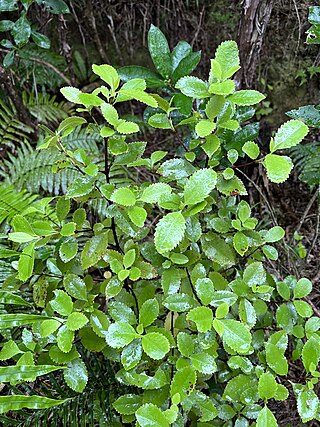
Gymnanthes lucida, commonly known as shiny oysterwood or crabwood, is a species of flowering plant in the spurge family, Euphorbiaceae, that is native to southern Florida in the United States, the Bahamas, the Caribbean, Mexico, and Central America.

Meryta is a genus in the flowering plant family Araliaceae. There are 28 described species in the genus and a number of undescribed species, all small, resinous trees of the subtropical and tropical Pacific Ocean, characterized by huge, simple leaves and a dioecious sexual system, a unique combination in Araliaceae. Meryta has its center of diversity in New Caledonia. Phylogenetic analyses have placed Meryta as a monophyletic genus in one of the three major clades of the Araliaciae, the Polyscias-Pseudopanax group, and more specifically in the Pacific Schefflera subclade.

Juania australis, the Chonta palm, is a species of flowering plant in the family Arecaceae, the only species in the genus Juania. It is a solitary trunked palm tree which is endemic to the Juan Fernández Islands archipelago in the southeast Pacific Ocean west of Chile.
Alphonsea lucida is a species of plant in the family Annonaceae. It is endemic to Peninsular Malaysia.
Klarobelia lucida is a species of plant in the Annonaceae family. It is endemic to Ecuador. Its natural habitat is subtropical or tropical dry forests. It is threatened by habitat loss.
Meryta brachypoda is a species of plant in the family Araliaceae. It is native to the islands of Raivavae and Rapa Iti in the Tubuai Islands of French Polynesia, and to Henderson Island in the Pitcairn Islands.
Meryta choristantha is a species of plant in the family Araliaceae. It is a tree endemic to the island of Rapa Iti in the Tubuai Islands of French Polynesia.
Meryta drakeana is a species of plant in the family Araliaceae. It is endemic to the island of Tahiti in the Society Islands of French Polynesia.
Meryta lanceolata is a species of plant in the family Araliaceae. It is a tree endemic to the islands of Bora Bora and Tahiti in the Society Islands of French Polynesia.
Meryta mauruensis is a species of plant in the family Araliaceae. It is a tree endemic to the island of Tahiti in the Society Islands of French Polynesia.
Meryta raiateensis is a species of plant in the family Araliaceae. It is a tree endemic to the island of Raiatea in the Society Islands of French Polynesia.
Meryta salicifolia is a species of plant in the family Araliaceae. It is a tree endemic to the island of Tahiti in the Society Islands of French Polynesia.
Meryta sonchifolia is a species of plant in the family Araliaceae. It is endemic to New Caledonia.
Parashorea lucida is a species of plant in the family Dipterocarpaceae. The name lucida is derived from Latin and refers to the venation on the leaf. It is a tall emergent tree, up to 60 m tall, found in mixed dipterocarp forest on clay and clay soils. It is found in Sumatra and Borneo. It is threatened by habitat loss.

Rawsonia lucida is a species of plant in the Achariaceae family. It is found in eastern, central and southern Africa.
Tristaniopsis lucida is a species of plant in the family Myrtaceae. It is endemic to New Caledonia.

Meryta latifolia, commonly known as broad-leaved meryta or shade tree, is an evergreen tree endemic to Norfolk Island, Australia, where it occurs in subtropical moist forest conditions.

Ascarina lucida, commonly known as hutu is a species of small tree in the family Chloranthaceae. It is endemic to New Zealand, being common on the West Coast and Nelson regions of the South Island and more rarely found in the North Island. A typical plant association is within the Westland podocarp/broadleaf forests with common understory associates of Blechnum discolor, Pseudowintera colorata, Neopanax colensoi and Coprosma lucida. Most genus members are dioecious, producing unisexual male or female flowers on separate plants. Ascarina lucida, the only member of its genus to occur in New Zealand, is monoecious. It will grow to a height of 6m and can have a 30 cm trunk. The leaves which are in opposite pairs are simple, yellowish green in color, have a raised mid rib and are very similar to Laurelia novae-zelandiae. Their margins have prominent teeth which are dark colored at the tips. Ascarina lucida is now nearly extinct in the Taranaki region but was last reported in Oct 1969 at Mt Taranaki, near Pukeiti by Colin Ogle.

Hyoseris frutescens is a species of flowering plant called Żigland t'Għawdex in Maltese and Maltese Hyoseris or Gozo Hyoseris in English. This species is endemic to the Maltese islands, where it is frequent and widespread in Gozo but rare in Malta. It was first discovered on Gozo, hence its second English name, then later found on the larger island Malta, in three separate localities. Its distribution range covers the entire western half of the perimeter on the island of Gozo, while on the island of Malta it is found on pocket isolated populations along the western cliffs of the island. It occurs in habitats such as cliffs, coastal garigue, rubble walls and boulder screes, and mainly in shady areas. The Maltese Hyoseris is one of the most archaic species in its genus to date. It is easy to cultivate by seed and it flowers all year round, but mostly in Spring and early Summer. Seeds are small achenes each with a pappus and are distributed by wind. It is a perennial species.
Hybosida lucida is a species of spiders found on Mahe Island in the Seychelles.







